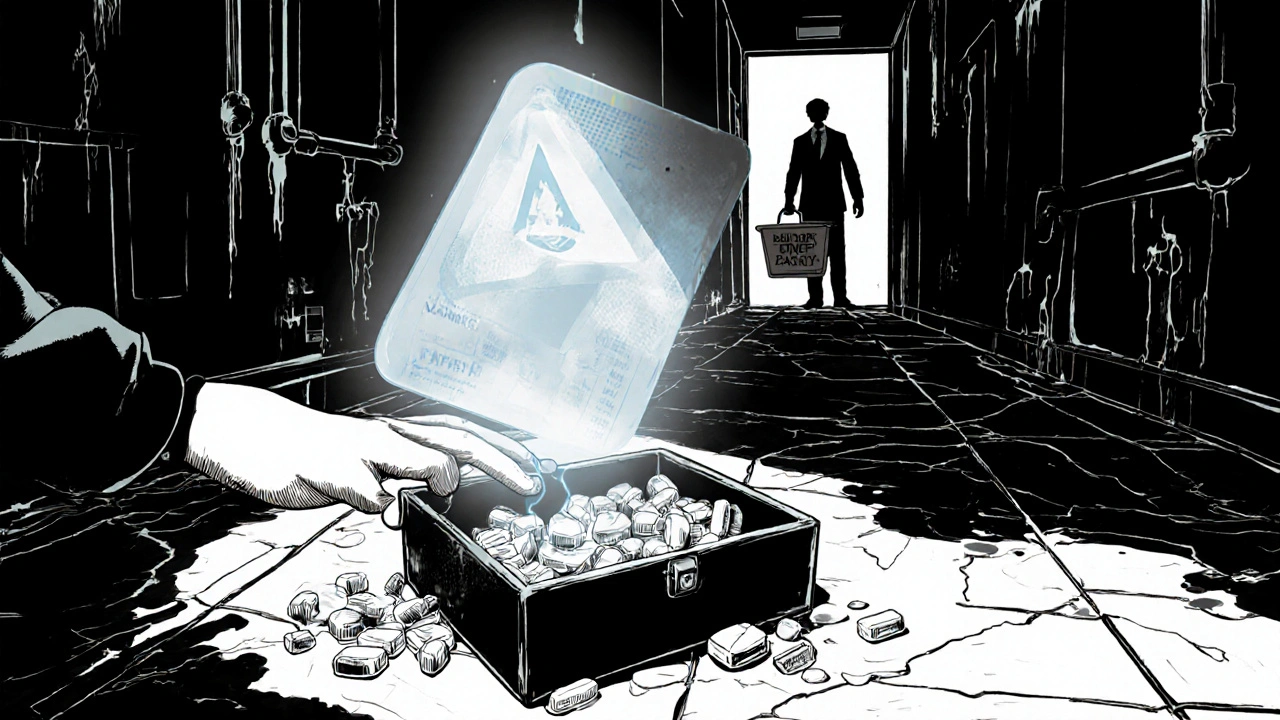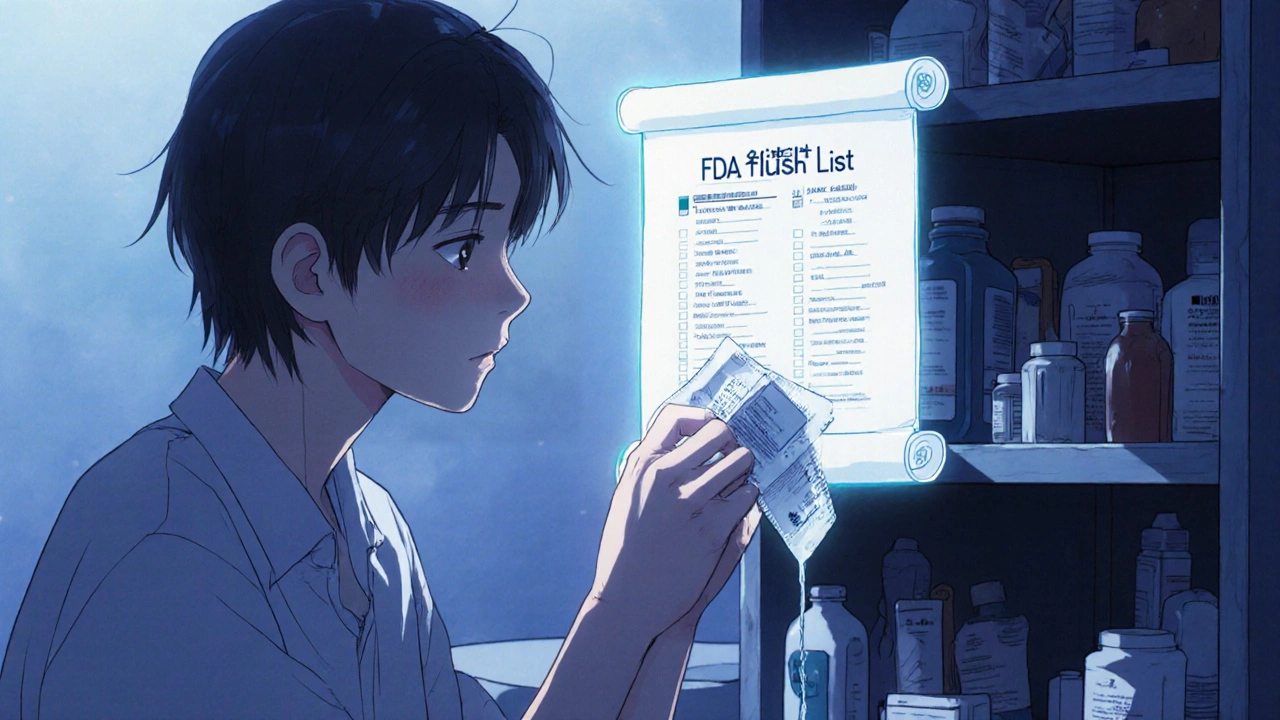Most people think flushing pills down the toilet is bad for the environment-and they’re right. But there’s a small, critical list of medications the FDA says you should flush anyway-not because it’s convenient, but because not doing it could be deadly.
Why the FDA Lets You Flush Some Medications
The FDA doesn’t encourage flushing drugs. In fact, their top recommendation is always to use a drug take-back program. But when those aren’t available, and a medication is powerful enough to kill a child or pet with one accidental dose, the FDA makes an exception. This isn’t about convenience. It’s about preventing immediate, irreversible harm.In 2012, after several children died from touching discarded fentanyl patches found in trash cans or on the floor, the FDA updated its guidance. They realized: if a dangerous drug ends up in the trash, someone might find it. If it’s flushed, it goes into a sewage system that’s designed to break down waste-not into a toy box or a pet’s mouth.
The EPA agrees. They say flushing should only happen in households where children or pets might access medications in the trash. Hospitals, nursing homes, and pharmacies are strictly forbidden from flushing drugs. This rule exists for a reason: the environmental impact of flushing is real, but the risk of overdose is worse.
The Official FDA Flush List (2024 Update)
As of April 2024, the FDA’s Flush List includes only 15 active ingredients. These aren’t random drugs. They’re all high-risk, fast-acting, and deadly in small amounts. Here’s what’s on the list:- Buprenorphine (found in SUBOXONE, BELBUCA, BUTRANS, ZUBSOLV)
- Fentanyl (ABSTRAL, ACTIQ, DURAGESIC patches, FENTORA, ONSOLIS)
- Hydromorphone (EXALGO extended-release tablets)
- Meperidine (DEMEROL)
- Methadone (DOLOPHINE, METHADOSE)
- Morphine (ARYMO ER, AVINZA, EMBEDA, KADIAN, MORPHABOND ER, MS CONTIN, ORAMPH SR)
- Oxymorphone (OPANA, OPANA ER)
- Tapentadol (NUCYNTA, NUCYNTA ER)
- Sodium oxybate (XYREM, XYWAV)
- Diazepam rectal gel (DIASTAT, DIASTAT ACUDIAL)
- Methylphenidate transdermal system (DAYTRANA)
That’s it. Only these. Not ibuprofen. Not antibiotics. Not your grandma’s blood pressure pills. Just these 11 classes of drugs that can stop breathing in seconds if misused.
For fentanyl patches, the FDA gives one extra step: fold the patch in half, sticky sides together, before flushing. This reduces the chance of someone accidentally sticking to it or exposing skin to leftover drug. It’s a small action-but it matters.
What You Should NEVER Flush
Flushing anything not on this list is a bad idea-and often illegal in many areas. Here’s what stays out of the toilet:- Antibiotics (like amoxicillin or azithromycin)
- Antidepressants (sertraline, fluoxetine)
- Cholesterol meds (atorvastatin, simvastatin)
- Diabetes pills (metformin, insulin)
- Pain relievers (ibuprofen, acetaminophen)
- Supplements and vitamins
These don’t kill instantly, but they pollute waterways. The U.S. Geological Survey found traces of 8 flush-list drugs in 23% of tested streams-but also found dozens of other medications in water supplies from improper disposal. The EPA says flushing non-listed drugs contributes to long-term ecological damage, even if the doses are tiny.
And here’s the kicker: a 2023 survey by the National Community Pharmacists Association found that 42% of Americans have flushed medications not on the FDA list. That’s not just wrong-it’s dangerous. You’re not helping the environment. You’re risking lives.

How to Check If Your Medication Belongs on the List
Don’t guess. Don’t rely on memory. Here’s how to be sure:- Look at the prescription label. The active ingredient is listed right under the drug name.
- Search the FDA’s official Flush List page (FDA.gov/DrugDisposal).
- Check the medication’s patient information leaflet. Many now include disposal instructions.
- Ask your pharmacist. Most can confirm within seconds.
For example: if you have SUBOXONE, you’re covered. If you have SUBUTEX (which also contains buprenorphine), you’re covered. But if you have naloxone (Narcan), you’re not. Naloxone saves lives-it doesn’t need to be flushed.
What to Do Before You Flush
Even if your drug is on the list, don’t rush. Follow these steps:- First, try a take-back program. The DEA runs National Take Back Days twice a year-in April and October. But you don’t have to wait. Use the DEA’s online collection site locator to find year-round drop-off locations near you.
- If no take-back is available within 24 hours, and the drug is on the FDA list, then flush.
- Remove all personal info from the bottle before tossing it in the trash. Cross out your name, prescription number, and address.
- For patches: fold sticky side to sticky side. For pills: flush them whole. Don’t crush or dissolve.
Why remove personal info? Identity theft. Prescription bottles are full of data. A 2023 study showed that 1 in 5 discarded pill bottles still had readable patient details. That’s a privacy risk.
Why Take-Back Programs Are Still Best
There are over 12,000 authorized collection sites in the U.S. But access isn’t equal. In cities, you might find one every 15,000 people. In rural areas, it’s one per 50,000. That’s why flushing is allowed as a last resort.But here’s the truth: most people don’t know where to take their meds. A 2023 survey by the American Pharmacists Association found that 78% of patients had no idea local take-back options existed. That’s why so many end up flushing the wrong things-or keeping them in drawers where kids can find them.
Take-back programs don’t just protect the environment. They prevent misuse. The National Survey on Drug Use and Health found that 9.5 million Americans misused prescription painkillers in 2022. Many got them from family medicine cabinets.
If you can drop off your meds-even if it’s just once a year-you’re helping more than you know.

What’s Changing in 2025?
The FDA is reviewing the Flush List regularly. In 2021, they removed 11 drugs because newer versions had abuse-deterrent features that made them safer in trash. In 2023, they started looking at adding new transdermal formulations after 17 cases of accidental buprenorphine exposure in children.By 2025, the FDA may remove up to three more drugs from the list if their new formulations prove safer. That’s how this system works: it’s not static. It adapts based on real-world data.
Meanwhile, the Bipartisan Infrastructure Law of 2021 gave $15 million to expand take-back sites. The DEA reports a 37% increase in collection locations since then. Progress is slow-but it’s happening.
Real Stories Behind the Numbers
Between 2010 and 2022, the FDA documented 217 cases of accidental fentanyl exposure in children. Nine of them died. One parent found a patch stuck to a playground slide. Another child swallowed pills from a purse left on the couch. These aren’t hypotheticals.On Reddit’s r/pharmacy, users share stories like: “I found a used fentanyl patch on a park bench. I wore gloves to pick it up. It still had enough drug to kill someone.” That’s why the FDA says: if you can’t safely dispose of it, flush it.
It’s not about being eco-friendly. It’s about being responsible.
What If You’ve Already Flushed the Wrong Thing?
If you flushed a non-listed medication, don’t panic. One or two pills won’t ruin a river. But don’t do it again.Start now: check your medicine cabinet. Remove anything expired or unused. Put it in a sealed bag with coffee grounds or cat litter (to make it unappealing), then throw it in the trash. That’s the FDA’s second-best option for non-flush-list drugs.
And next time you get a prescription, ask your pharmacist: “Is this on the FDA Flush List? And where’s the nearest take-back site?”
Can I flush expired antibiotics?
No. Antibiotics are not on the FDA Flush List. Flushing them contributes to water pollution and antibiotic resistance. Instead, mix them with coffee grounds or cat litter, seal them in a bag, and throw them in the trash. Always use a take-back program if available.
What if my pharmacy doesn’t take back meds?
Many pharmacies don’t accept returns due to state laws. Use the DEA’s online locator to find authorized collection sites-hospitals, police stations, and some retailers like CVS and Walgreens participate. If none are nearby and you have a flush-list drug, follow FDA guidelines: flush it. For all others, use the trash method with kitty litter or coffee grounds.
Is it safe to flush pills down the toilet if I have a septic system?
Yes, if the medication is on the FDA Flush List. The FDA’s guidance applies regardless of your sewage system. The risk of accidental overdose outweighs potential septic system concerns. For non-flush-list drugs, avoid flushing entirely-even with septic systems. Use the trash method instead.
Why doesn’t the FDA just make all drugs safer to throw away?
Some are. Many newer opioids now come with abuse-deterrent features-like pills that turn to gel when crushed. The FDA removed 11 drugs from the list in 2021 because of these improvements. But for older, highly potent drugs like fentanyl patches, there’s no safe way to dispose of them in the trash. That’s why flushing remains a last-resort option.
Can I flush medications if I live in New Zealand?
No. The FDA Flush List only applies in the United States. New Zealand has its own guidelines through the Ministry of Health. In New Zealand, all unused medications should be returned to pharmacies for safe disposal. Flushing is not permitted under any circumstances. Always check local rules-even if you’re following U.S. advice.

